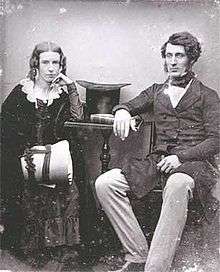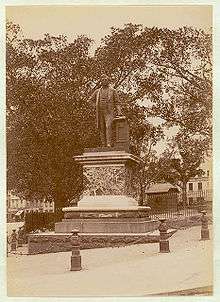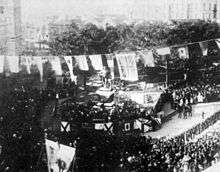Thomas Sutcliffe Mort
Thomas Sutcliffe Mort (23 December 1816 – 9 May 1878) was an Australian industrialist who improved the refrigeration of meat. He was renowned for speculation in the local pastoral industry as well as industrial activities such as his Ice-Works in Sydney's Darling Harbour and dry dock and engineering works at Balmain.
Thomas Sutcliffe Mort | |
|---|---|
 Mort and his first wife, Theresa, photographed c. 1847 | |
| Born | 23 December 1816 Bolton, Lancashire, England |
| Died | 9 May 1878 (aged 61) Bodalla, New South Wales, Australia |
| Occupation | Industrialist; grazier; philanthropist |
| Organization | Goldsbrough Mort & Co; later to become Elders Limited |
| Known for | Improving refrigeration of meat |
| Spouse(s) |
|
Businessman

Mort was born in Bolton, Lancashire, England in 1816. In 1878, he was associated with the Australian Mutual Provident Society. In 1849, he was one of a committee, which funded a company to promote sugar growing at Moreton Bay. In 1850 Mort was a member of the Sydney Exchange Co, and in 1851 he was a director of the Sydney Railway Co. and was also involved in mining (gold, later also copper and coal) and other enterprises. In the 1850s, he opened Mort's Dock in Sydney, a business that was not as successful as he wished.[1] In 1843, he established Mort & Company, in Sydney,[2] and held the first wool auction there,[3][4] which was the beginning the wool auction system.
Mort returned to England for a visit in 1857–59. During that visit he bought many furnishings, pictures and other goods, in particular at a sale of the possessions of the Earl of Shrewsbury. He commissioned the architect Edmund Blacket to build a house to add to his house to display the new possessions. His gallery was open to the public.
From 1856, Mort began acquiring land near Moruya on the south coast of New South Wales. In 1860, Mort acquired the Bodalla estate near the mouth of the Tuross River. Mort eventually owned 15,000 hectares (38,000 acres) in the district, a very substantial holding in that fertile area. Bodalla is alleged to have been originally known as 'Boat Alley'. Mort's vision for Bodalla was as a country estate to retire on and to demonstrate model land utilisation and rural settlement. Mort wished to have a tenanted dairy estate run as an integrated whole.[1]
Mort replaced the beef cattle that had been farmed there and carried out extensive improvements including clearing land, draining river swamps, erecting fences, laying out farms, sowing imported grasses, and providing milking sheds, cheese and butter-making equipment. Butter and cheese were produced for the Sydney market. By the 1870s, the tenants were disgruntled sharefarmers and the estate was in Mort's control again run as three farms with hired labour.
In 1866, Mort expanded his dry dock into an engineering works. Mort offered shares to his employees and in 1875, the company was incorporated with limited liability having been managed beforehand by a committee that included four leading hands. This was one of the earliest attempts at co-operation between capital and labour in Australia, and although the effort at sharing ownership was only partially successful, Mort always had good relations with his employees.
Also in the mid-1860s, Mort had been looking at refrigeration as a way of developing manufacturing orders, to ensure better access to the Sydney market for the butter and cheese he was producing at Bodalla and to offset the vulnerability of being exposed to falling wool prices. Mort financed experiments by Eugene Dominic Nicolle, a French born engineer who had arrived in Sydney in 1853 and registered his first ice-making patent in 1861.
In 1861 Mort established at Darling Harbour the first freezing works in the world, which afterwards became the New South Wales Fresh Food and Ice Company. The first trial shipment of frozen meat to London was in 1868. Although their machinery was never used in the frozen meat trade, Mort and Nicolle developed commercially viable systems for domestic trade, although the financial return on that investment was not a great success for Mort.
As a part of his refrigeration works, Mort developed a large abattoir at Lithgow where sheep and cattle from western New South Wales were slaughtered and refrigerated for later transport.[5]
Mort was a prominent Anglican layman. He donated the land for St Mark's Church, Darling Point, and commissioned Edmund Blacket to design the church. Mort contributed to the upkeep of the church[6] and also to the building of St. Andrew's Cathedral, Sydney and St Paul's College, University of Sydney. He was also the founder of Christ Church School in Pitt Street, Sydney.
Death and legacy

Thomas Mort died of pneumonia at Bodalla on 9 May 1878.[1]
At the time of his death he was spoken of as "the greatest benefactor the working classes in this country ever had". Within a week, a meeting of working men in Sydney had resolved to show their esteem; a sculpture in Macquarie Place by Pierce Connolly was unveiled in 1883.[7]
Mort is also commemorated by All Saints Church, Bodalla, built in his honour by his family, to a design by Blacket, using granite quarried on Mort's property. The foundation stone was laid in 1880. It was completed in 1901. The church has one of seven small Henry Willis & Sons organs. The church cost A£13,000.[8]
Mort's business Mort & Co. became Mort & Co Ltd in 1883. It merged with R Goldsbrough & Co Ltd in 1888 to form Goldsbrough Mort & Co Ltd. In 1963 a merger formed Elder Smith Goldsbrough Mort Ltd which traded until 1982. The present day business is Elders Limited.[9]
The southern Sydney suburb of Mortdale and its main road, Morts Road, are named after him.[10] His house in Darling Point which he called Greenoaks became the home of the Anglican Archbishop of Sydney on 24 October 1910 and was renamed Bishopscourt. It was listed on the New South Wales State Heritage Register in 1999.[11]
See also
Notes
- Harris, Charles Alexander (1894). . In Lee, Sidney (ed.). Dictionary of National Biography. 39. London: Smith, Elder & Co.
- "Mort & Co - History". Mort & Co. Retrieved 2 March 2019.
- Interpretive signage in the small museum display about the wool industry at the 'Big Merino', Goulburn, N.S.W. (accessed Nov. 2018)
- "Advertising". Sydney Morning Herald (NSW : 1842 - 1954). 17 November 1843. p. 1. Retrieved 21 January 2019.
- "Thomas Sutcliffe Mort and Refrigeration Works". History of Lithgow. lithgow-tourism.com. Archived from the original on 9 September 2005. Retrieved 19 February 2006.
- "St Marks Anglican church". New South Wales State Heritage Register. Office of Environment and Heritage. Retrieved 19 March 2018.
- Wyner, Issy (2003). "Unveiling Mort's Statue, Macquarie Place, Sydney, 1883 (includes photograph)". My Union Right or Wrong. A history of the Ship Painters and Dockers Union 1900–1932. www.takver.com. Retrieved 19 February 2006.
- "History of all Saints Church, Bodalla"; church pamphlet
- Smith, Bruce A. (2005). "Mort & Co (1849–1888)". Guide to Australian Business Records. www.gabr.net.au. Archived from the original on 21 December 2005. Retrieved 19 February 2006.
- Mortdale Early Days
- "Bishopscourt". New South Wales State Heritage Register. Office of Environment and Heritage. H00362. Retrieved 1 June 2018.
References
- Barnard, Alan (1974). "Mort, Thomas Sutcliffe (1816–1878)". Australian Dictionary of Biography. Melbourne University Press. ISSN 1833-7538. Retrieved 28 April 2009 – via National Centre of Biography, Australian National University.
- Serle, Percival (1949). "Mort, Thomas Sutcliffe". Dictionary of Australian Biography. Sydney: Angus and Robertson. Retrieved 28 April 2009.